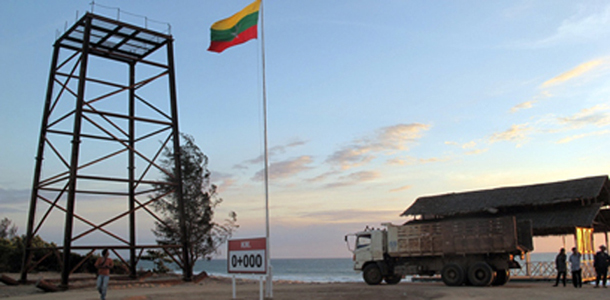A new plan by Thailand to build a port on its own stretch of the Andaman coast may signal the end of the multi-billion dollar dream of creating a major industrial center at Dawei (Tavoy) on Burma’s southeast coast.
The ink is beginning to fade on the Dawei project, which was first agreed in a memorandum of understanding between the two countries’ governments four years ago in May 2008.
The project, involving oil trans-shipment docks and petrochemical plants, made no progress until the Burmese regime change in late 2010 raised the prospect of third-party financial backing.
Dawei’s main licensed developer, Bangkok-based construction firm Italian-Thai Development (ITD), began trumpeting grand US $50 billion schemes drawing in investment from Japan, South Korea and possibly China, as well as major Thai conglomerates such as state-owned oil and gas group PTT.
The Dawei project, supposed to spur economic development of Burma’s sleepy rural southeast, appeared set for rapid advance, but since January this year has stalled.
Japanese industrial giants suddenly seem more interested in the Thilawa Port development close to Rangoon.
Meanwhile, the Thai government last week gave approval for a new port on Thailand’s Andaman Sea south of Dawei at the small fishing village of Pak Bara.
That surprise plan was disclosed by the specialist British magazine Port Strategy, quoting Thai Deputy Transport Minister Chadchart Sittipunt.
“One reason for the decision to push on with Pak Bara is the continuing uncertainty over the Dawei mega-port in Myanmar,” Port Strategy reported. “The government believes if Dawei does go ahead, Pak Bara can supplement it and if doesn’t happen it will be a useful port in its own right even though Mr Sittipunt acknowledged ‘the hinterland is limited.’”
“Dawei is currently stalled as government policy changes and its developers search for investors,” said the magazine.
Sittipunkt was quoted as saying that ITD was “trying to get money” to kick-start Dawei while the Thai government and private sector were “taking a wait-and-see approach.”
Developing Dawei appeared to stall after the Burmese government blocked ITD’s plans for a massive 4,000-megawatt coal-fuelled power plant there on environment grounds. It later turned out that much of the electricity produced by the plant was intended to be pumped to Thailand rather than help develop the Burmese southeast.
ITD’s port plans have been further upset by Burmese President Thein Sein’s recent visit to Japan in which he interested major industrial conglomerates in the Thilawa Port expansion outside Rangoon.
Thein Sein met senior managers from Sumitomo, Mitsubishi, Itochu and Marubeni. Now specialists from Marubeni and Sumitomo are due to help draw up a technical report on how best to develop Thilawa, and also improve Burma’s electricity system.
“Maybe the Burmese have twigged that developing Dawei, while having some pluses for Burma’s southeast corner, will largely benefit Thailand,” Bangkok-based energy industries consultant Collin Reynolds told The Irrawaddy on April 27.
“It’s too far removed from Burma’s potential industrial corridor along the Irrawaddy River, but it’s perfectly located as an annex to a Bangkok trade hub.”
“The latest Thai plan to build another port on the Andaman Sea further south on the Thai coast makes no strategic sense at all, and may well be a ruse to push the Burmese into lifting restrictions like no coal-burning power plant. You’d have to bet on a Thilawa investment as the most sensible plan for Burma.”
Certainly if Burma is to enjoy the economic boom which so many business pundits are predicting, it will need modern ports to boost import and export trade. At present it has very little big tonnage capacity.
Two ports being developed on the Bay of Bengal are limited and relatively isolated—Sittwe close to Bangladesh and Kyaukpyu on Ramree Island.
Just as Dawei seems more likely to benefit Thailand, so Sittwe is better suited to India’s need to provide a sea link for its landlocked northeast states. Indian companies are currently investing around $120 million in rejuvenating the old rice exporting port.
Kyaukpyu is a Chinese invention aimed primarily at fulfilling Beijing’s desire to provide an oil transhipment link via the Indian Ocean to its landlocked southwest region, using Burma as a pipeline conduit.
“Certainly Dawei was and is a Thai story, so if there is any slacking of interest there then the project has no other reason for being,” Burma economics expert Prof. Sean Turnell, of Macquarie University in Australia, told The Irrawaddy on Sunday.
However, the Thais insist that Dawei is intended to be a regional hub which would slot Burma into a trading web linking India, China and key Asean countries such as Vietnam.
Thailand’s National Economic and Social Development Board says a major port at Dawei complements Greater Mekong sub-region schemes for developing economic trade routes.
A fledgling road linking sleepy Dawei with the Burma-Thailand border and the Thai town of Kanchanaburi has been established, but there is little sign that this is about to grow into the eight-lane super highway and tandem fast railway envisaged by ITD’s chief Premchai Karnasuta.
ITD and some of its Thai backers, including state oil giant PTT Group and Ratchaburi Electricity Generating Holding—45 percent owned by the Thai state—have said that they will announce revised decisions in May or June.

















